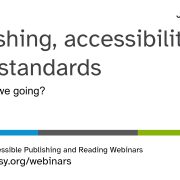WCAG 2 and Internationalization

W3C’s Web Content Accessibility Guidelines (WCAG), which forms the foundation of the EPUB Accessibility Specification, include success criteria that provide guidance on the presentation of text, including when users apply styles that change features of text. This has, at times, led to confusion and concerns about whether these success criteria apply to content in all languages and writing systems.
In this article, we’ll explore how the recently released WCAG 2.2 provides additional clarity for two such success criteria and highlight the next steps the Working Groups are taking to address these concerns.
Text Spacing
The first issue raised by the W3C Internationalization Working Group during the 2.2 revision, and supported by the DAISY Consortium, was with Success Criterion 1.4.12 Text Spacing.
This success criterion focuses on ensuring that content remains readable and usable when users change line heights, letter spacing, word spacing, and the amount of space after paragraphs. For example, changing letter spacing should not result in a button label being partially obscured because the text becomes wider than the button. Similarly, changing line heights should not cause the content to be cropped at the edge or bottom of a page so that it is no longer readable.
Although beneficial for some writing systems, these requirements are not beneficial to all. Japanese text, for example, often uses line spacing that is wider than the basic requirement while using first-line indentation to indicate new paragraphs rather than relying on space after paragraphs. In addition, specific writing systems may have additional requirements that are just as important but that this success criterion does not cover.
Additionally, authors sometimes misread the success criterion as requiring them to style their content to meet the specified settings, but the minimum requirements only set the bar at which content must not fail when users re-style the content.
The Accessibility Guidelines Working Group, the maintainers of WCAG, did not intend to imply the success criterion’s requirements are universal or that they are content styling requirements. The success criterion is not trying to enumerate the requirements for every writing system or set display minimums. The design of WCAG is to incrementally improve content for as many users as possible when techniques are proven to enhance accessibility.
To help make these points clearer, the Text Spacing Success Criterion now includes two notes to address the concerns raised:
- The first note clarifies that the author’s responsibility is only to ensure that content remains accessible at the specified settings, as users can change these settings in their reading systems per their needs.
- The second note clarifies both that the settings do not always apply to every language and writing system and that authors should follow any additional language-specific best practices that improve the readability of the text.
Visual Presentation
The second issue raised by the Internationalization Working Group was related to Success Criterion 1.4.8 Visual Presentation.
This success criterion also aims to ensure that content remains accessible as users adjust display settings. For example, it requires that users be able to resize the text up to 200% without having to scroll horizontally to read lines, that users be able to control foreground and background colours, and that users be able control the justification of lines.
The concern raised here was that these requirements only sometimes apply to vertically written text, and the success criterion does not indicate what to do when this is not the case.
Like with the previous issue, it was not the intention of the WCAG working group that users be able to control the settings where they do not apply or affect the accessibility. It is another case where WCAG addresses what it can to help the people it can.
To make this clearer, the Visual Presentation Success Criterion now includes a note explicitly stating that the requirements do not apply to writing systems that do not need or use a presentation setting. It also notes that there may be additional presentation settings that could help users of other writing systems and not to ignore them because the success criterion does not mention them.
The working group also added a second note to clarify that it is not authors who have to add mechanisms to control these settings when the user agent already provides controls. EPUB reading systems, for example, are widely available that allow users to change the font size, text and background colours, line justification and other properties noted in the success criterion.
It is also worth noting that this success criterion falls at level AAA. So even if it is not perfect for all writing systems, publishers typically do not have to meet it for regulatory purposes – level AAA is most often considered aspirational and the guidelines themselves note they should not be required for conformance.
Next Steps
Getting these two issues addressed in WCAG 2.2 was a helpful step in improving the understanding of how WCAG applies to different languages and writing systems, but it is not the end of the work. The Internationalization Working Group and Accessibility Guidelines Working Group WCAG 2.2 taskforce will continue working together to write potential errata and update informative documents such as the Understanding documents (for example, see issue 3343 and issue 3345 in the Working Group’s tracker). The results of this joint effort will better highlight other internationalization practices and remove other possible sources of confusion.
The development of WCAG 3 also presents another opportunity to bring more internationalization issues into focus and to ensure that the guidelines are developed with international audiences in mind. If these issues are important to the work you do, we encourage you to participate in the Accessibility Guidelines Working Group and contribute to the development of WCAG.
DAISY Consortium would like to give special thanks to the Accessibility Guidelines Working Group chairs and W3C staff contact for reviewing and providing invaluable input on this article.






